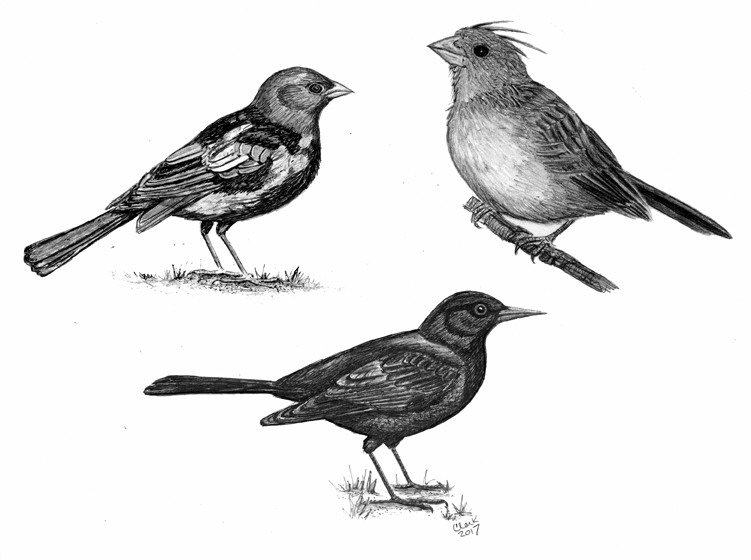
Dear Bird Folks,
I hate to disagree with the late Roger Tory Peterson, but his field guide tells me that grackles have yellow eyes. Today my wife and I saw three grackles on our feeder, and not one of them had yellow eyes. Do I need a new bird book?
– Todd, Chatham, MA
I get this question a lot, Todd,
At least once a day a customer will come in and tell me that he or she has just seen a bird that’s “not in any bird book.” Upon hearing this familiar phrase, I typically smirk and then spend the next twenty minutes attempting to solve the mystery bird, which invariably is in their bird book. I have yet to come upon a bird that wasn’t in a standard field guide…except in the summer. This time of year we are likely to see all sorts of strange looking birds. It’s not that these exotic birds have been blown in by storms or have traveled here for a vacation. They are basically “regular” birds but they are in the midst of transforming from babyhood to adulthood. This process only takes a few weeks, so their images aren’t always included in field guides…and the birds prefer it that way. Like a teenager’s middle school photos, some things are better off forgotten.
Don’t ask me why, but for some reason people confuse grackles with starlings. To help them remember which is which, I remind them that grackles are the ones with the spooky yellow eyes. However, just to make things more confusing, young grackles don’t acquire the aforementioned yellow eyes until later in the year. This is why the three birds in your yard don’t match Roger’s images. It’s an age thing. Now that I’ve gotten that sorted out, I have to decide whether to continue writing about grackles or switch to weird-looking baby birds. I think I’m going with the babies. I get enough grackle (aka, starlings) talk (aka, complaints) all day at work.
Cardinals may be everyone’s idea of a perfect bird, but they don’t start off so perfect. Both male and female cardinals have bright red beaks, but the beaks of their babies are ugly brown. Some cardinal fans are upset by this imperfection and think they have defective birds. Not to worry. By the end of summer your cardinals will all be impeccably handsome once again.
One of the strangest young bird field marks has to do with woodpeckers. I think everyone knows that many male woodpeckers have a distinctive red patch on the back of their heads. But youngsters have the red patch on their foreheads instead. I’m not sure of the reason for this, but like most kids, they probably do it just to annoy their parents. Speaking of being annoying: At 5:30 this morning I woke up to the sound of a young male flicker calling just outside of my bedroom window. Through my sleep-filled eyes I could see that the top of the bird’s head was completely red (and not just a spot on the back). I had never seen a flicker like this before, so I scrabbled out of bed to fetch my camera. In my haste I knocked over a wastebasket. Not wanting to wake my wife, I quietly picked up the trash and then continued looking for my camera. Eventually, I found it and was able to take a few decent shots before the bird flew off. I was quite proud of myself until I turned around and saw my wife sitting up glaring at me. Uh, oh. I tried to explain what was going on, but she just gave me the “whatever” look, rolled over and went back to sleep. How could she not be excited about seeing a young flicker at 5:30AM? I mean what else is there to do at that time?
Some young birds molt so slowly that we barely notice the change, but this is not the case with cowbirds. Young male Brown-headed Cowbirds are basically dull brown and look very much like females. They will look this way until August, when they’ll begin to molt. The molting process produces a bizarre patchwork of black and gray feathers, making them look like they need to see a dermatologist. Molting young House Finches might even give you nightmares. Occasionally, a few baby feathers will remain sticking out of their heads, even after their adult feathers have grown in. These peculiar birds appear to have sprouted horns and will fool you into thinking you’ve seen a tiny flying devil…even before happy hour.
Other birds, such as chickadees, don’t have an obvious juvenile plumage. But that doesn’t mean we can’t tell the kids from the adults. The mouth of a nestling is usually bright yellow, which creates an easy target for the parents returning with food. Ultimately, this color becomes more muted. But until that happens, bits of yellow maybe seen on the corners of a young bird’s mouth, making it look like mustard stains left over from eating a foot-long hotdog…and I think we’ve all been there.
A mistake people sometimes make when identifying baby birds has to do with size. They assume a baby must be smaller, but that’s not how it works. When songbirds are able to fly, they are pretty much full-grown. With their quivering wings, constant begging and overall confused looks, fledglings are still obviously young. Just because they are the size of an adult, it doesn’t mean they will act like one…much like a lot of people we know. Maybe someday someone will write a field guide that features all of these goofy baby birds, Todd. If they ever do, I think you should buy a copy for your wife, but don’t give it to her at 5:30AM. Apparently, that’s not the best time of day to discuss birds. Don’t ask me why.